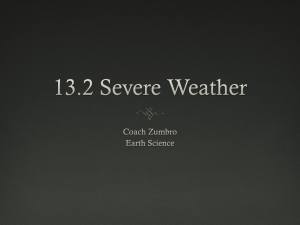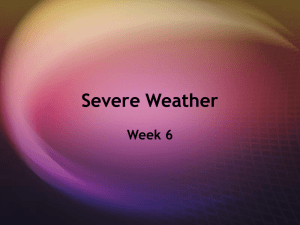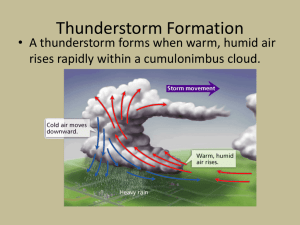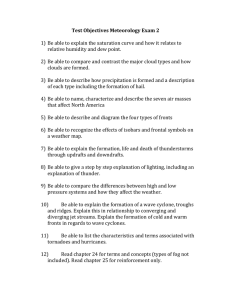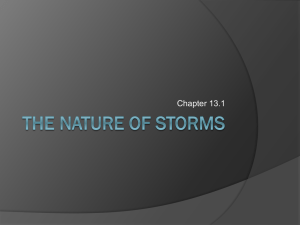Chapter 10 Lecture PowerPoint Tornadoes, Lightning, Heat and Cold 1
advertisement
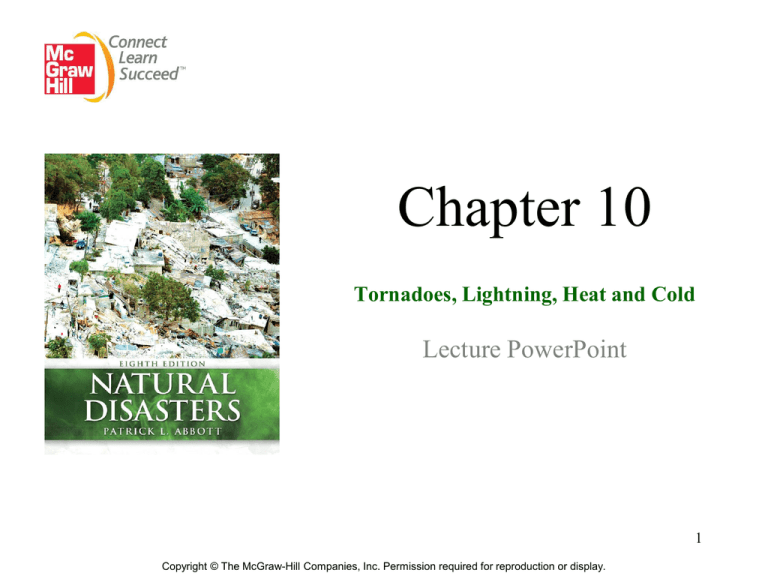
Chapter 10 Tornadoes, Lightning, Heat and Cold Lecture PowerPoint 1 Copyright © The McGraw-Hill Companies, Inc. Permission required for reproduction or display. Tornadoes, Lightning, Heat and Cold Natural Disasters, 8th edition, Chapter 10 Severe Weather • Causes about 75% of yearly deaths and damages from natural disasters • More people killed usually by severe weather than by earthquakes, volcanoes, mass movements combined • From 1980 to 2009, U.S. had 96 weather-related disasters causing more than $1 billion (each) in damages • Total more than $700 billion Cold and Nor’Easters • • Hypothermia can set in if our body temperature is lowered to below 95 degrees F (normal body temperature is 98.6 degrees F). Signs include uncontrollable shivering, slurred speech, memory loss, incoherence and apparent exhaustion. First step in treatment: warm the body core! Going the other way, body temperatures above 104 degrees F can be life threatening (Hyperthermia!). Signs include that can lead to heat stroke include high body temperature, mental confusion, staggering, strange actions, fainting and dry skin with rapid or slow pulse. Much of severe weather in mid-latitudes of the N-hemisphere occurs via cyclones: air masses rotating counterclockwise about a low pressure core. Some of these large-scale cyclones are linked to troughs in the jet stream. In NE US and Canada theses cyclones can create powerful storms called nor’easters. Moving up the eastern US and Canadian coastline, this low pressure system (with CCW rotation) can bring different air masses into contact: warm-moist air off the Atlantic; and on western (or landward) side, can draw cold air down from the north. COLLISION of COLD ARCTIC AIR and WARMER OCEANIC AIR can create powerful nor’easters. Winter Storms The Eastern U.S. “Storm of the Century” of 1993 • Immense cyclone covered area from Cuba to Canada between March 12 to 15 • Killed 270 people, more than $8 billion in damages • Large trough in jet stream caused collision of three air masses over Florida: – Low-pressure, warm, moist air from Gulf of Mexico – Fast-moving frigid arctic air mass from north – Rainy, snowy east-moving air mass from Pacific • Rode jet stream north up coast In Greater Depth: Doppler Radar • Measures relative velocity between two objects – Radar guns for police – Velocities in sports – Describing weather systems • Radar detects precipitation using reflection of microwaves • Reflectivity increases as precipitation increases • Allows life-saving advance warnings Figure 10.5 Winter Storms Blizzards • Strong cyclone with winds at least 60 km/hr and below freezing temperatures, blowing/falling snow • Cyclone may travel slowly though winds are fast Northeastern United States, 6-8 January 1996 • Canadian blizzard dropped record snowfalls in Ohio, Pennsylvania, West Virginia, New Jersey – Wind speeds exceeding 80 km/hr – Killed 154 people • Followed immediately by warm weather and heavy rains destructive flooding Winter Storms Ice Storms • Precipitation falls as snow flakes or ice particles • May pass downward through air warm enough to cause melting to rain • If rain then enters below-freezing layer near ground, refreezes into sleet • If rain is not in below-freezing layer long enough to refreeze, becomes supercooled, and then refreezes as soon as comes into contact with ground or solid object, forming coating of ice Winter Storms Figure 10.4 Canadian Ice Storm, 5-9 January 1998 • 80 hours of freezing rain • 25 people died of hypothermia, $7 billion in damage • Power system collapsed under immense damage, had to be rebuilt Winter Storms Lake-Effect Snow • Common along eastern shores of Great Lakes • Cold air moves over warmer waters • Great quantities of snow along shoreline • Most likely during late fall and early winter • Also occurs elsewhere around the world How Thunderstorms Work • Air temperature normally decreases upward from surface at about 6oC/km: lapse rate – If lapse rate is greater than 6-10oC/km, atmosphere is unstable • Rising warm, moist air may begin condensation, releasing latent heat and providing energy for severe weather, building cloud top higher How Thunderstorms Work Figure 10.12 How Thunderstorms Work • Early stage: requires continuous supply of rising, warm, moist air to keep updraft and cloud mass growing • Mature stage: – Upper-level precipitation begins when ice crystals and water drops become too heavy for updrafts to support – Falling rain causes downdrafts, pulling in cooler, dryer air – Updrafts and downdrafts blow side by side, creating gusty winds, heavy rain, thunder and lightning, hail • Dissipating stage: downdrafts drag in so much cool, dry air that updrafts necessary to fuel thunderstorm are cut off How Thunderstorms Work Downbursts: An Airplane’s Enemy • Violent downdrafts of cold air with rain and hail during mature stage of thunderstorm • Especially dangerous to airplanes, pushing plane into ground before pilot can react – Airplanes also threatened by horizontal wind shear – wind shift from head winds (necessary to maintain lift) to tail winds How Thunderstorms Work • Northern Hemisphere cyclone: counterclockwise air mass rotating around low-pressure core • Large scale: trough in jet stream juxtaposes northern cold front and southern warm front line of thunderstorms – Northeastern U.S.: low-pressure system moving up Atlantic coast draws northern cold air, moisture from east nor’easter • Medium scale: individual thunderstorms • Small scale: tornado Figure 10.13 Air-Mass vs. Severe Thunderstorms Air Mass Thunderstorms: Most common type , result from convection Common in low latitudes all year Common in mid-latitudes in summer, especially late afternoon Severe Thunderstorms: Mid-latitude frontal collisions Figure 10.15 Thunderstorms in North America • Warm, moist air necessary for thunderstorm formation comes from Gulf of Mexico more thunderstorms in central and southern U.S., particularly Florida • Lifting mechanisms: convection (air-mass Tstorms), frontal (severe Tstorms), orographic and convergence. Figure 10.16 Thunderstorms in North America Heavy Rains and Flash Floods Thunderstorms can be major supplier of water to area Central Texas • Warm, moist air from Gulf of Mexico meets warm, dry air from west, forming dry line (thunderstorm trigger) • Air flow turned upward at escarpment of Balcones fault zone – eroded fault scarp 30 to 150 m high, 545 km long • Torrential thunderstorm downpours Thunderstorms in North America Hail • Layered ice balls dropped from storms with: – Buoyant hot air rising from heated ground – Upper-level cold air creating large temperature contrasts – Strong updrafts keeping hailstones aloft while adding layers • Most common in late spring and summer, along jet stream in colder midcontinent Figure 10.19 Thunderstorms in North America Destructive Winds • Straight-line winds can be as damaging as tornadoes • Widespread, powerful wind storm: derecho Derechos • Advancing thunderstorms form line of ferocious winds with hurricane-force gusts, lasting 10 to 15 minutes Ontario to New York Derecho, 15 July 1995 • Thunderstorms moving 80 mph with 106 mph gusts blew from Ontario to New York for two hours, in early morning (hot, humid air supplied energy to thunderstorms through night) Tornadoes • Rapidly rotating column of air from large thunderstorm • Highest wind speeds of any weather phenomenon (more intense and more localized than hurricanes) • About 70% of Earth’s tornadoes occur in Great Plains of central U.S. – Move from southwest to northeast • Travel up to 100 km/hr, wind speeds up to 500 km/hr • Core of vortex less than 1 km wide, sucks up objects • Form hundreds of meters high in atmosphere, may never touch ground Tornadoes How Tornadoes Form? • Three air masses (warm, humid, low Gulf of Mexico air; cold, dry, midaltitude Canadian or Rocky Mountain air; fast, high-altitude jet stream winds) moving in different directions give shear to thunderstorm • Rising Gulf air is spun one way by mid-altitude cold air then spun another way by jet stream corkscrew effect – Warm air rising on leading side – Cold air descending on trailing side Figure 10.21 Tornadoes How Tornadoes Form? • Thundercloud tilted by wind shear may grow into supercell thunderstorm – Rain falls with downdrafts in forward flank of storm – Warm air rises (updrafts) in middle of storm – Downdrafts of cool, drier air in trailing side of storm Tornadoes How Tornadoes Form? • Tornadoes form between middle updraft and rear downdraft • Rotation develops in wide zone – Core pulls into tighter spiral speed increases dramatically (angular momentum is preserved) • Downward-moving air in center surrounded by upward-spiraling funnel • Wind speeds highest few hundred meters above ground (slowed by friction at ground level) Tornadoes Tornadoes in the United States and Canada • Air masses collide in interior U.S. (world tornado capital), head NE • Occur any time, most common in late spring, early summer Figure 10.27 Figure 10.28 Tornadoes Tornadoes in the United States and Canada • Enhanced Fujita wind damage scale – EF-0, minor damage, up to EF-5, incredible damage Insert Table 10.3 here Tornadoes Tornadoes in the United States and Canada • Three main destructive actions: Insert Table 10.5 here – High-speed winds – Winds throw debris like bullets or shrapnel – Fast winds blowing into building rapidly increase air pressure inside, sometimes blowing roof up and walls out • Declining numbers of tornado deaths in recent decades – More risk to old people, mobile-home residents, occupants of exterior rooms with windows, those unaware of alerts – Safer in car than mobile home (lower center of gravity) Tornadoes Tri-State Tornado, 18 March 1925 • Largest known tornado moved at about 100 km/hr, through Missouri, Illinois and Indiana, leaving nearly 2 km wide path of destruction • Destroyed 23 towns and killed 689 people on 353 km long path Tornadoes The Super Outbreak, 3-4 April 1974 Figure 10.32 • Five weather fronts: – Cold front in Rocky Mountains – Low-pressure system moving east – Strong polar jet stream with bend to south – Warm, humid air from Gulf of Mexico – Dry air from southwest, overriding Gulf of Mexico air, forming unstable inversion layer (cold air over warm air) • All weather fronts came together, as Gulf of Mexico air burst up through inversion layer, creating thunderclouds set spinning by other converging air masses • In 16 hours, 147 tornadoes in 13 states, six tornadoes of F-5 force • Overwhelming destruction Tornadoes Tornadoes and Cities • 10 of 3,600 tornadoes between 1997 and 2000 struck cities, including Nashville, Salt Lake City, Fort Worth, Oklahoma City Safe Rooms • Traditional cellar rarely built in modern homes • Interior closet or bathroom built with concrete walls and roof, steel door • Safe even when rest of house destroyed Lightning Lightning • Leading cause of forest fires, major cause of weatherrelated deaths • Lightning distribution same as thunderstorm distribution Insert revised figure 10.38 here Figure 10.38 Lightning How Lightning Works • Flow of electric current: top of clouds’ excess positive charge seeks balance with bottom of clouds’ excess negative charge • Speeds up to 6,000 miles/second, in several strokes within few seconds Figure 10.40 Lightning How Lightning Works • Charge imbalance from freezing and shattering of super-cooled water drops – charge separations distributed by updrafts and downdrafts during early cloud buildup • Negative charge at bottom of cloud induces buildup of positive charge in ground below • Discharge begins within cloud, initiates downward stream of electrons stepped leader • As stepped leader nears ground, ground electric field increases greatly, sending streamers of positive sparks upward, connecting with stepped leader about 50 m above ground Lightning Don’t Get Struck • Lightning can strike up to 16 km from thundercloud • Area of risk extends wherever thunder can be heard • Avoid lightning: – Get inside house; don’t touch anything (lightning can flow through plumbing, electrical, telephone wires) – Get inside car; don’t touch anything (lightning usually flows along outside metal surface of vehicle, jumps to ground through air or tire) – If outside, move to low place, away from anything tall; assume lightning crouch – on balls of feet with hands over ears Lightning • Connection of stepped leader and upward streamers completes circuit, initiates return stroke of positive charge up to cloud How Lightning Works up to 55,000oF • More lightning strokes occur, temperatures Figure 10.42 Heat • Heat waves are invisible, silent killers. • Heat waves have been the biggest killer of all severe weather in U.S. for the past 30 years. Read about heat wave in Chicago (1995), Europe (2003) • Problems with heat are especially extreme in cities due to urban heat islands. End of Chapter 10
